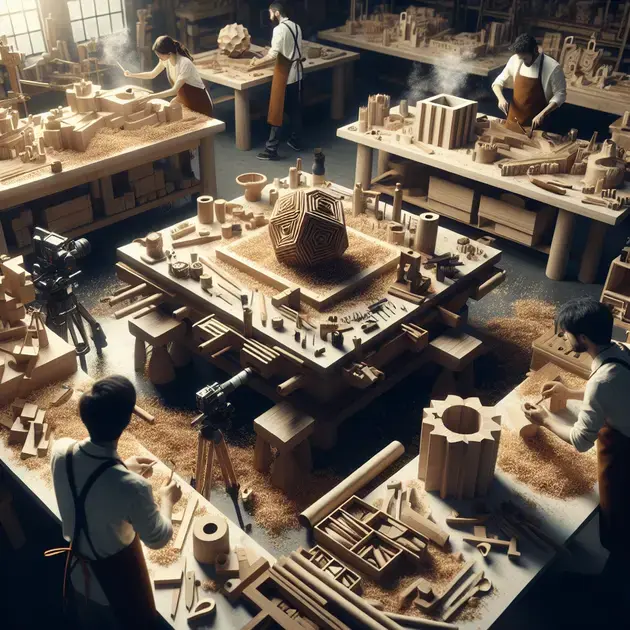Are you ready to embark on a woodworking journey but feeling lost in the vast sea of information available? Navigating the world of woodworking as a beginner can be a daunting task, but fear not, as this guide is here to help you navigate through the basics with ease
Woodworking has seen a resurgence in popularity in recent years, with more and more people turning to this timeless craft as a way to express their creativity and create unique pieces. Whether you’re looking to start a new hobby or dive into a potential career, this beginner’s guide will provide you with essential tips, techniques, and resources to kickstart your woodworking journey.

Navigating Woodworking Basics
Woodworking is a timeless craft that allows individuals to create beautiful, functional pieces using their hands and a few essential tools. If you’re new to woodworking, navigating the basics can seem overwhelming at first. However, with the right tips and guidance, you can kickstart your woodworking journey with confidence.
1. Understanding Wood Types
One of the first steps in woodworking is understanding the different types of wood and their characteristics. Hardwoods such as oak, maple, and cherry are durable and often used for furniture making, while softwoods like pine and cedar are more affordable and great for beginner projects.
To learn more about wood types, you can visit websites like Wood Database (www.wood-database.com) that provide detailed information on various woods, including their hardness, grain patterns, and best uses.
2. Essential Woodworking Tools
Having the right tools is crucial for a successful woodworking project. Start with basic tools like a hammer, saw, tape measure, and chisels. As you progress, you can invest in power tools like a table saw, drill press, and router.
You can find comprehensive guides on essential woodworking tools on woodworking websites like The Spruce Crafts (www.thesprucecrafts.com), which offer recommendations for beginners and tips on how to use each tool safely.
3. Learning Basic Woodworking Techniques
Before diving into complex projects, it’s essential to master basic woodworking techniques. Practice making simple joints like butt joints, miter joints, and dado joints to understand how wood pieces come together.
Websites like Popular Woodworking (www.popularwoodworking.com) offer tutorials on woodworking techniques, complete with step-by-step instructions and videos to help you hone your skills.
4. Safety First
Woodworking can be a rewarding hobby, but it also comes with potential risks. Always prioritize safety by wearing protective gear like goggles, ear defenders, and a dust mask. Additionally, make sure your workspace is well-ventilated and free of clutter.
You can find safety guidelines and recommendations on woodworking safety from organizations like the Occupational Safety and Health Administration (OSHA) at www.osha.gov, which outline best practices for a safe woodworking environment.

Unlocking Your Creativity in Woodworking
Woodworking is a versatile and creative craft that allows individuals to express their artistic vision through the manipulation of wood. To unlock your creativity in woodworking, it is essential to experiment with various techniques, tools, and designs. One way to spark your creativity is by challenging yourself to think outside the box and try new methods of woodworking. By exploring different styles and approaches, you can uncover unique ways to showcase your skills and create stunning pieces of art.
Another way to enhance your creativity in woodworking is by drawing inspiration from sources outside the woodworking world. For example, you can look to nature, architecture, or even fashion for ideas that can be translated into woodworking projects. By incorporating elements from different disciplines, you can develop a more eclectic and innovative approach to woodworking.
Furthermore, collaborating with other woodworkers and attending workshops or classes can also help unlock your creativity. By sharing ideas, techniques, and experiences with fellow craftsmen, you can gain fresh perspectives and insights that can inspire you to push the boundaries of your creativity. Additionally, learning from experts in the field can expose you to advanced techniques and concepts that can elevate your woodworking skills to new heights.
Overall, unlocking your creativity in woodworking requires a combination of experimentation, inspiration, and collaboration. By embracing new challenges, exploring diverse sources of inspiration, and engaging with the woodworking community, you can expand your creative horizons and take your woodworking skills to the next level.
Mastering Advanced Techniques in Woodworking
Mastering advanced techniques in woodworking is a rewarding journey that requires dedication, patience, and practice. One essential step in mastering advanced techniques is to familiarize yourself with a wide range of woodworking tools and equipment. From hand tools like chisels and planes to power tools such as routers and table saws, having a comprehensive understanding of different tools will empower you to tackle complex woodworking projects with confidence.
Another key aspect of mastering advanced techniques is honing your woodworking skills through focused practice and repetition. By consistently challenging yourself with progressively difficult projects, you can refine your techniques and improve your precision and craftsmanship. Additionally, seeking guidance from experienced woodworkers or enrolling in advanced woodworking courses can provide you with valuable insights and strategies for mastering intricate woodworking techniques.
Furthermore, exploring specialized areas of woodworking, such as joinery, carving, and marquetry, can help you expand your repertoire of skills and techniques. By delving into these niche areas, you can develop a deeper understanding of advanced woodworking principles and enhance your ability to execute intricate and sophisticated designs.
In conclusion, mastering advanced techniques in woodworking is a continuous learning process that requires a combination of knowledge, practice, and exploration. By immersing yourself in the world of advanced woodworking and challenging yourself to grow and improve, you can elevate your woodworking craftsmanship to a professional level.
Building Your Skillset in Woodworking
Building your skillset in woodworking is a gradual and fulfilling journey that begins with mastering the fundamental techniques and gradually progressing to more advanced skills. One crucial step in building your skillset is to start with the basics, such as learning how to measure and cut wood accurately, assemble joints, and finish surfaces. By establishing a strong foundation in basic woodworking skills, you can lay the groundwork for further skill development.
As you gain proficiency in basic woodworking techniques, you can then expand your skillset by exploring intermediate skills such as designing and constructing furniture, creating intricate woodcarvings, and incorporating decorative elements into your projects. By challenging yourself with progressively more complex tasks, you can broaden your expertise and versatility as a woodworker.
Additionally, seeking feedback and guidance from experienced woodworkers can help you identify areas for improvement and refine your skills. Constructive criticism and mentorship can provide valuable insights and tips for enhancing your craftsmanship and expanding your skillset in woodworking.
Furthermore, investing in quality tools and materials, attending woodworking workshops and exhibitions, and experimenting with new techniques and styles can also contribute to building your skillset in woodworking. By staying curious, open-minded, and committed to continuous learning and growth, you can enrich your woodworking capabilities and embark on a rewarding journey of skill development and creative expression.
Conclusion
Woodworking is a craft that offers endless opportunities for creativity and self-expression. To unlock your creative potential in woodworking, experimentation, inspiration, and collaboration are key. By stepping out of your comfort zone and exploring new techniques and designs, you can push the boundaries of your woodworking skills and create truly unique pieces of art. Drawing inspiration from various sources outside the woodworking world, such as nature and architecture, can bring a fresh perspective to your projects and fuel your creativity.
Mastering advanced techniques in woodworking is a journey that requires dedication and continuous learning. Familiarizing yourself with a wide range of tools and equipment, honing your skills through practice, and exploring specialized areas like joinery and carving can elevate your craftsmanship to a professional level. Seeking guidance from experienced woodworkers and enrolling in advanced courses can provide valuable insights and strategies for mastering intricate techniques.
Building your skillset in woodworking is a fulfilling process that begins with mastering the basics and gradually progressing to more advanced skills. By starting with fundamental techniques and expanding to intermediate skills like furniture design and woodcarving, you can broaden your expertise and versatility as a woodworker. Investing in quality tools, attending workshops, and seeking feedback from experienced craftsmen are essential steps in enhancing your skills and fostering continuous growth in the world of woodworking.